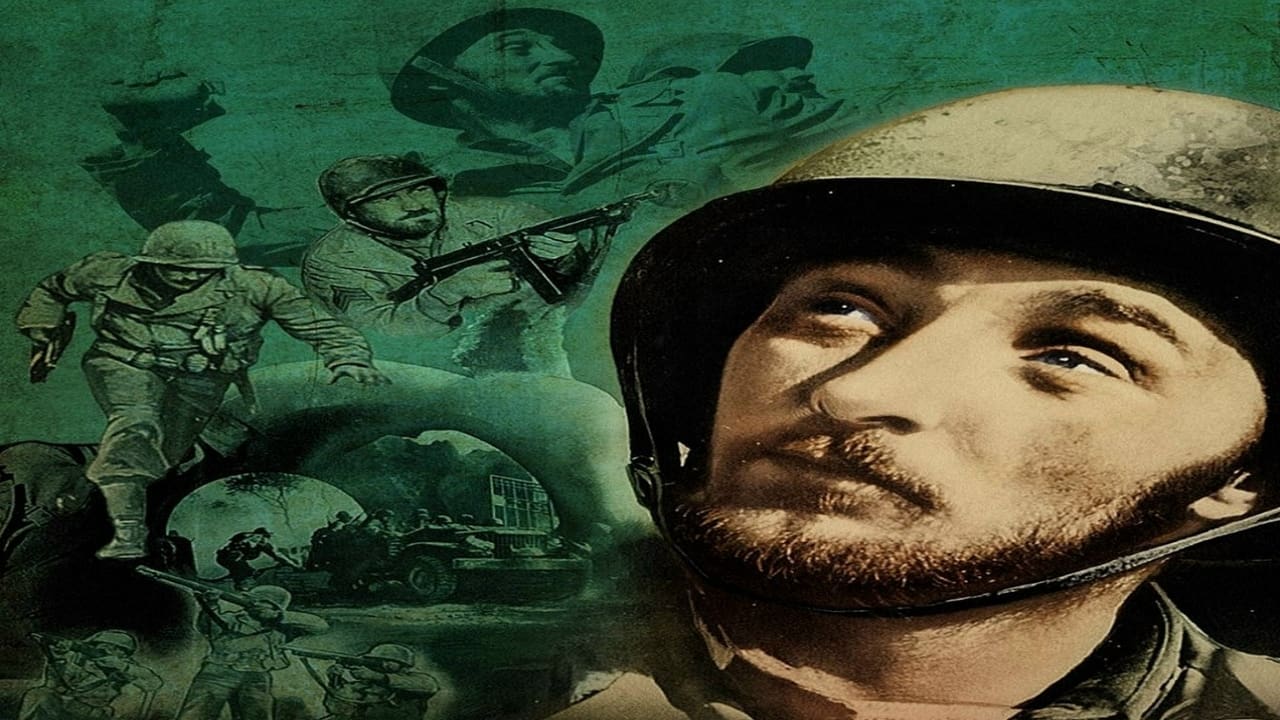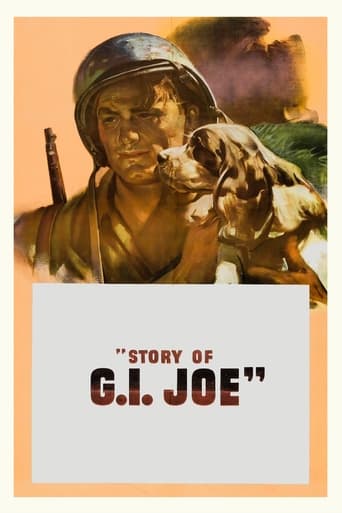

"The Story of GI Joe" is a biography – and almost feels like a documentary – of the famous US World War II correspondent Ernie Pyle (played by Burgess Meredith) as he covers the gritty exploits of Company C of the US 18th Infantry. The director, William Wellman, based the movie upon Pyle's Pulitzer Prize winning book. Pyle was a rare breed. He insisted on being on the front lines with our GIs so as to get the right account of what was really happening with the average Joe. His purpose was not to carry a weapon but to take notes and send true stories back home about young soldiers who expressed their fears and concerns, and who felt their way thorough their first combat. Pyle stuck with the soldiers through heavy rains, mud holes, flowing streams, and combat situations. Pyle's dispatches showed the home front parents what their boys were going through. Initially the slow-paced film begins in North Africa (February 1943) and covers the American reverse at the hands of the Axis forces of Field Marshall Rommel at the Kasserine Pass. After that it moves quickly over the American victories in Africa and the conquest of Sicily. Then the rest of the movie's focus is the war in Italy (up to the capture of Rome), especially the battles of San Vittorio and Mt. Cassino (a sixth century abbey). As for the latter, the Germans did not use its strategic position until it was bombed. But the rubble made them a favorable defensive position. The US soldiers – mechanics, construction men, office workers, etc. before the war – are well led by the humane Lt. Walker (Robert Mitchum). Walker, outside of Pyle, gets the most attention. But Sgt. Warnicki (Freddie Steele), Pvt. Donaro (Wally Cassel), and Pvt. Murphy (John Reilly) also have sizable parts to play. When Warnicki enters a bombed out Catholic Church to pray, he leaves his helmet on. It's a good thing he did so. Donaro confronts a frightened Italian woman, but note her relief when he speaks Italian. Murphy's company gives him the use of a most unusual bridal suite after he marries his fiancée, a nurse. Supporting roles were also played by actual combat veterans of North Africa, Sicily, and Italy. Meredith comes across very well as the sincere and humble war correspondent. The movie is convincing and natural: There are no heroics here, no John Wayne valor, no patriotic slogans. General Eisenhower called this the greatest war movie that he had ever seen. Ironically, the real Ernie Pyle never saw this movie. It premiered in 1945, after the fall of Germany (European Theater of Operations, ETO) but with the Pacific Theater of Operations (PTO) still in progress. Pyle had already left Europe for the western Pacific, and was killed during the last battle of the war (Okinawa) in April 1945.
... View MoreSkip it – This movie has a very "old" feel to it. Unlike other classics made during this time, it has not aged well. Also, it lacks the Hollywood heroics usually associated with a war movie. It is for this unique reason that a lot of people actually like this unconventional 1945 WWII movie co-starring a super young Robert Mitchum. I could compare it to "Band of Brothers" because the story is about the unit rather than a single main character. Replacements come and go but the story always focuses on the unit. But "Band of Brothers" actually had some good fight scenes. This movie only has one good combat sequence. So instead, I will compare this film to "All Quiet on the Western Front" because instead of focusing on combat, it focuses more on the rain and mud and "trench" hardships of the war. 1 action rating
... View MoreThis film is an odd mix. In spots the dialog and situations are cornier than Capra. But it is the first real attempt to depict (at least in part) some of the day to day hardships of the regular GI.Since the war was still on when this picture was made (released in 1945), the message had to be at least somewhat hopeful and yet it struck a mix not unlike some of Pyle's dispatches from the front. It certainly feels much more realistic than some earlier efforts like In Which We Serve (1942) The idea of filming on location hadn't been adopted yet, and the North Africa scenes filmed in California have a "wrongness" about the feel that hurts the early scenes in the picture. Also, some anachronisms in the equipping of the GI's will stand out as well to anyone familiar with newsreel footage or some of the better made documentaries that have been made since. The later footage that is supposed to be in Italy doesn't suffer as much from the lack of actual locations.Much of the picture revolves around an effort to get past a mountain guarded by an ancient monastery. The film somewhat rewrites history at this point in an attempt to exorcise some of the errors in judgment that later came to be associated with the bombing of Monte Cassino.Several filmic techniques are used a bit heavy handedly as well. Care is taken to keep the Germans a faceless, inscrutable foe. There is one scene where the lighting is very dramatically (and somewhat obviously)arranged so that a dark shadow is cast by a captured German's helmet. We don't have to see much of his face and certainly not his eyes.The use of the puppy is a bit overdone. Using a puppy to whine when we should be feeling sad is a bit heavy handed. Conversely the filmic trick of using the noise of nearby explosions to cover/censor one soldier's lewd comments is done with a wink and a nod to the audience. It's clear that film makers knew we'd get the joke. Since it was wartime, no American soldiers were shown too terribly mangled or with graphic / disturbing injuries. Rapid jump cuts were used very effectively in several key battle scenes to heighten the tension without having to overdo the special effects.One plot element was a bit weird though. A GI receives a record containing his son's first recorded words. The GI has never heard his kid speak and tries repeatedly to get the record to play on a phonograph that he "liberates" For some inexplicable reason the recording seems to have been recorded backwards so that all the GI can hear is garbled. Yet at one crucial moment he tries again and the recording this time seems to play fine despite it being obvious that he's done nothing differently. A bit more care in staging this could have made it actually work.Another thought that occurred to me several times while watching this picture was that while regular GI's were overseas actually fighting and dying for their country. The actors and crew involved in this film were safe at home. I've seen many other pictures made during war-time but somehow the confluence of this picture's message and the facts that I now know in retrospect made that somewhat jarring.Overall, I found this film to be WORTH watching but it didn't engage me the way that more well made films have. Still, releasing this shortly after Ernie Pyle's death in combat must have helped make it as successful as it was.
... View MoreThis is a beautiful movie. Its most celebrated scene is of two men in a tent, one a war correspondent, named Ernie Pyle, the other an army captain, called Walker. They are shown together commiserating about the men the latter one feels responsible for sending to their deaths. This is an idle moment, an intermission from the killing but not the squalor, composed of words, rain, mud and pregnant pauses between swigs of a shared bottle of grappa. Nothing "happens" except that the viewer is privy to a communion of souls and the spectacle of what seems like the two most believable actors (Burgess Meredith as Pyle, and Robert Mitchum as Lt. Capt. Bill Walker, respectively)to ever share screen space and time together in the same motion picture.In his famous review of it, James Agee compared the packed emotionalism of GI JOE's final lyrical outburst with the elegiac verses of Whitman's Civil War poetry and while the great author of "Let Us Now Praise Famous Men" and "A Death In The Family" was wont to gush about certain pet favs of his (John Huston, the 'Silent Age' of Charles Chaplin, and a documentary approach to the cinema, in general, spring most immediately to mind) on this occasion, when composing the longest essay he ever devoted to a single picture, I believe Agee got it exactly right for of all the war films dealing directly with the miserable business of fighting and dying and soldiering on regardless, only THE DEER HUNTER comes remotely close to equalling its weary blend of stoical honor and boundless remorse in the face of such heartbreaking images of battle.The anecdotal design of THE STORY OF G.I. JOE (the underrated, deceptively original script is by Leopald Atlas and Guy Endure) frustrates as standard narrative mechanism but coheres poetically as a whole, as an ode to the nobility of the human spirit. It ingeniously incorporates surprisingly choice ingredients of the period: the overcast quality of Robert Capa's combat photos haunt the cinematography and give this William Wellman film an expressive look (and grace) none of his others possess; the early scenes in the African desert and a hurried-up wedding between a WAAC and enlisted man have the flavor of a series of mordant Bill Maulden cartoons. Most obviously, there are the words of Pyle himself, especially the inspiring ones culled from "The Death of Captain Waskow," spoken by Meredith on the soundtrack that conclude the movie.Wellman wraps it together with the utmost tact and unerring sensitivity (qualities not usually associated with him)- with a divine instinct that seems to derive from the beyond. This makes it the greatest of Memorial Day movies. In its stark juxtaposition of brutal inevitability (the men look out for each other like muddy boots dangling in the wind, ready to drop) and the recording of amazingly tender impulses under duress, G.I JOE is the most cathartic of fighting films. It wasn't until the Peckinpah westerns that anybody surpassed it.
... View More